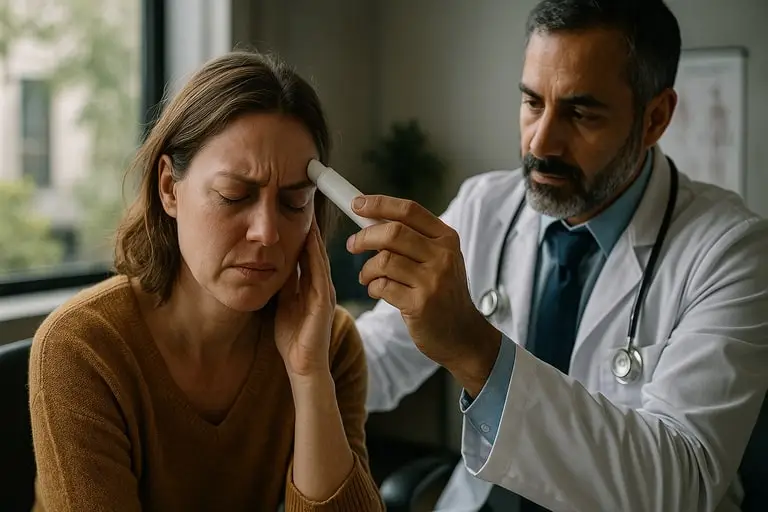Migraines are not ordinary headaches but complex neurological disorders that disrupt daily life with severe pain, sensitivity to light and sound, nausea, and often a sense of unpredictability. Understanding migraine treatment means acknowledging the biological, psychological, and lifestyle dimensions of the condition while tailoring solutions to individual needs. Millions of people suffer from migraines worldwide, yet too many endure without proper care because of underdiagnosis, stigma, or misconceptions. Relief is possible, but it requires an expert-guided combination of medication, preventive strategies, and lifestyle adjustments.
Medical approaches to migraine treatment often begin with acute relief medications, which target attacks once they start. Triptans, ergot derivatives, and newer calcitonin gene-related peptide (CGRP) receptor antagonists work by narrowing blood vessels and altering pain pathways in the brain. These treatments reduce the duration and severity of migraines, helping patients regain control of their daily activities. Still, not every drug suits every patient, and side effects must be considered. This highlights why professional evaluation is vital rather than self-medication.
Preventive therapies form another cornerstone of migraine treatment. For individuals with frequent or disabling attacks, daily preventive medications such as beta-blockers, anticonvulsants, and antidepressants reduce the number of episodes. Recently, monoclonal antibody therapies targeting CGRP have revolutionized migraine prevention. These advances show how modern medicine moves beyond treating symptoms toward modifying the underlying mechanisms. For many, this represents the difference between living in fear of the next attack and reclaiming a predictable life.
Lifestyle modification complements medical treatment significantly. Regular sleep, hydration, balanced nutrition, and stress management reduce triggers that provoke migraines. Identifying personal triggers such as caffeine, alcohol, hormonal changes, or irregular meals helps patients avoid unnecessary suffering. The role of lifestyle is not secondary but central, because even the best medications cannot fully overcome poor habits that exacerbate migraines. Recognizing this empowers individuals to take an active role in their treatment.
Non-pharmacological therapies enrich the spectrum of migraine treatment. Cognitive behavioral therapy, biofeedback, acupuncture, and mindfulness practices show promising results in reducing migraine frequency and improving coping strategies. These approaches help regulate stress responses and restore balance in neurological pathways. Integrating such therapies offers patients choices beyond pharmaceuticals, ensuring a holistic approach that respects the mind-body connection.
Emerging therapies also reshape the landscape. Neuromodulation devices, which use electrical or magnetic stimulation, provide non-invasive relief during or between migraine attacks. Some patients find them especially helpful when medication is ineffective or poorly tolerated. These innovations highlight the rapid evolution of migraine science, offering hope to those who previously had few options. They also represent the importance of personalized medicine—no single treatment works for everyone, but tailored plans maximize success.
Children and adolescents present unique challenges in migraine treatment. Because their nervous systems are still developing, not all medications are appropriate. Pediatric migraine care emphasizes lifestyle management, trigger avoidance, and gentle therapies, while reserving medication for severe cases under specialist supervision. This demonstrates how treatment must adapt across life stages, always prioritizing safety while ensuring relief.
The psychological burden of migraines deserves as much attention as the physical pain. Anxiety, depression, and social withdrawal often accompany chronic migraines, compounding disability. Effective treatment must therefore include psychological support, counseling, and community awareness. Acknowledging this dimension fosters empathy and ensures patients receive comprehensive care that addresses both visible and invisible impacts.
Women frequently face migraine patterns influenced by hormonal fluctuations, particularly during menstruation, pregnancy, or menopause. Tailoring treatment to these stages improves outcomes. Hormonal therapy, careful medication selection, and lifestyle adjustments reduce the gender-specific burden of migraines. These considerations reveal how migraine treatment is not one-size-fits-all but a highly individualized process shaped by biology and context.
Ultimately, migraine treatment is about restoring quality of life, not just reducing pain. Patients seek predictability, functionality, and freedom from fear of the next attack. By combining modern medicine, preventive strategies, lifestyle balance, and psychological care, treatment becomes truly transformative. The goal is not only fewer headaches but a fuller, more empowered life. This comprehensive vision reflects the best of patient-centered healthcare.
In conclusion, migraine treatment demands a multi-dimensional strategy that integrates acute relief, prevention, lifestyle, and psychological support. Advances in medicine, combined with holistic care, have transformed migraines from an inescapable curse into a manageable condition. For patients willing to engage in comprehensive treatment plans, the prospect of lasting relief and restored daily functioning is real. Knowledge, awareness, and persistence form the key pillars of success.
Migraine Treatments and Therapeutic Solutions
While the term migraine treatment suggests a singular approach, in reality there are many migraine treatments that reflect the complexity of the disorder. Migraines vary in severity, triggers, and frequency, requiring flexible and patient-specific solutions. This diversity explains why medical science emphasizes a wide range of therapeutic options rather than a uniform prescription. Each method targets different stages of migraine pathology, from preventing attacks to shortening their duration.
Acute therapies remain the first line for many. Simple pain relievers such as NSAIDs provide relief for mild migraines, though overuse can lead to rebound headaches. More targeted drugs such as triptans and gepants are reserved for moderate to severe attacks, offering rapid improvement. Some patients combine approaches under medical supervision, ensuring balance between efficacy and safety. This underscores how multiple migraine treatments often coexist within one person’s care plan.
Preventive treatments shape long-term outcomes. Medications including propranolol, topiramate, and amitriptyline lower attack frequency. Newer injectable biologics specifically designed for migraine prevention represent breakthroughs in patient care. Their effectiveness with relatively few side effects demonstrates how medical innovation directly improves lives. Patients once resigned to monthly suffering now report dramatically reduced episodes. This transformation illustrates the power of modern migraine treatments.
Non-drug treatments play an equally important role. Acupuncture, yoga, biofeedback, and relaxation techniques reduce attack frequency by calming the nervous system and improving resilience. These approaches also empower patients, giving them tools for active self-management. The success of such methods reinforces that migraine treatment is not confined to medicine alone. It blends science with lifestyle and patient empowerment.
For individuals with chronic migraines—defined as 15 or more headache days per month—Botox injections have proven effective. Administered every few months, Botox reduces the number of headache days and improves quality of life. This therapy shows that even seemingly unconventional approaches can provide real relief when applied with evidence-based precision. Chronic migraine requires different treatments than episodic migraine, and recognizing this distinction prevents frustration for patients and physicians alike.
Lifestyle-driven migraine treatments include structured sleep schedules, balanced diets, exercise, and hydration. While seemingly simple, these adjustments create stable neurological patterns that reduce susceptibility to attacks. Skipping meals, dehydration, or erratic sleep are powerful migraine triggers, which means correcting these habits is not optional but fundamental. Patients often find that when lifestyle and medical treatments work together, the results exceed what either could achieve alone.
Women’s health remains a central consideration. Menstrual-related migraines, for instance, respond differently to treatment. Short-term preventive medications or hormonal interventions may be necessary. Pregnancy requires even more careful choices, as many standard medications pose risks. Individualized planning ensures safety while still providing relief. Gender-specific approaches remind us that migraine treatments must be as diverse as the patients they serve.
Pediatric migraines emphasize non-drug strategies first, since children are especially vulnerable to medication side effects. Stress management, hydration, and regulated routines form the foundation, with medications added cautiously when necessary. Early recognition of pediatric migraines is critical, as untreated symptoms can impair learning and development. Parents and doctors must work together to balance relief with safety.
The integration of technology further expands migraine treatment. Mobile apps for tracking symptoms and triggers, wearable devices for neuromodulation, and online support communities connect patients with resources and care. Technology ensures that migraine treatments are not isolated to the clinic but extend into everyday life, empowering people to understand and manage their condition more effectively.
The social impact of chronic migraines cannot be ignored. Work absences, decreased productivity, and relationship strains often accompany unmanaged migraines. Comprehensive treatment reduces not only pain but also these broader consequences, restoring individuals to their personal and professional lives. Effective treatment thus holds value not only for patients but for families, workplaces, and communities.
In the end, migraine treatments form a spectrum ranging from acute relief to long-term prevention, from medication to lifestyle, and from traditional approaches to cutting-edge innovations. The variety reflects the complexity of the disorder itself. Patients who explore and combine these treatments under expert guidance discover that life with migraines can be managed successfully. What once seemed inevitable can be transformed into stability, freedom, and hope.
Migraine Treatment and Headache Relief Strategies
For many, the phrase migraine treatment is inseparable from the broader goal of headache relief. Migraines are distinct from tension or cluster headaches, but they share overlapping management strategies. Exploring migraine treatment in this context highlights not only disease-specific solutions but also general approaches that reduce headache burden across conditions. This inclusive perspective benefits patients who may struggle to distinguish their exact headache type without medical guidance.
First, effective relief requires proper diagnosis. Migraines present with unilateral throbbing pain, often accompanied by nausea, vomiting, and light sensitivity. Yet many patients mislabel severe tension headaches as migraines or assume sinus headaches are to blame. Accurate diagnosis ensures that migraine treatment is tailored correctly rather than wasted on ineffective methods. Neurologists rely on patient history, symptom patterns, and sometimes imaging to clarify the distinction. Without diagnosis, even the best treatment plan risks failure.
Acute headache relief strategies overlap with migraine treatment. NSAIDs, triptans, and anti-nausea medications remain essential tools. However, timing is critical; taking medication at the earliest sign of a migraine attack increases effectiveness. Delays reduce efficacy, prolonging suffering. Patients educated about early intervention consistently report better results, demonstrating that treatment success is not only about the drug itself but also about when it is taken.
Lifestyle strategies once again prove vital. Regular hydration, consistent sleep, reduced screen time, and stress control prevent headaches across categories. For migraines specifically, avoiding triggers such as certain foods, alcohol, and sensory overload makes attacks less frequent. For other headaches, posture correction, ergonomic workspaces, and relaxation techniques reduce strain. This overlap illustrates that lifestyle serves as a universal foundation for headache relief.
Non-drug therapies further support both migraine and general headache treatment. Biofeedback trains individuals to recognize early tension and control responses, acupuncture stimulates natural pain relief pathways, and mindfulness lowers stress-induced episodes. These therapies provide practical tools that reduce reliance on medications, particularly for those who experience side effects or prefer holistic approaches. Their growing scientific validation confirms their role in modern treatment plans.
The role of stress deserves special attention. Stress remains one of the most consistent triggers for both migraines and tension headaches. Effective treatment therefore requires stress management techniques integrated into daily routines. Meditation, breathing exercises, yoga, and cognitive behavioral therapy all reduce the physiological impact of stress. These approaches lower cortisol levels, stabilize mood, and enhance resilience against headache triggers. Stress management is not optional—it is central to successful treatment.
Children and adolescents again require careful strategies. Their developing brains react differently to medications, so pediatricians emphasize non-drug methods first. Sleep hygiene, hydration, and screen-time regulation prove particularly effective. When medication is necessary, doses are carefully tailored. Education for families ensures children receive support at school and home, minimizing disruption. Pediatric headache management reflects the broader principle that treatment must be individualized across all age groups.
The workplace presents unique challenges for headache sufferers. Long hours, screen exposure, poor ergonomics, and high stress amplify symptoms. Employers and employees both benefit when migraine treatment and headache relief strategies include workplace adjustments. Breaks, ergonomic setups, flexible scheduling, and supportive policies reduce absenteeism and improve productivity. Treatment, in this context, has both health and economic benefits.
Advances in neuroscience continue to expand headache relief options. CGRP-targeting drugs, neuromodulation devices, and personalized digital health platforms represent cutting-edge strategies. They complement established treatments, offering new hope for those who fail traditional options. Innovation ensures that migraine treatment and general headache care will keep evolving, providing patients with better outcomes year after year.
Ultimately, the goal of migraine treatment and headache relief strategies is not only to reduce pain but to restore functionality, independence, and well-being. Patients want more than temporary fixes—they want freedom from unpredictability and the ability to live fully. Comprehensive care, spanning diagnosis, medication, lifestyle, and psychological support, delivers this outcome. Relief becomes more than an aspiration; it becomes a reality when treatment is pursued thoughtfully and persistently.
Migraines are among the most debilitating neurological conditions, often striking with little warning and causing intense pain that disrupts daily life. For many, these attacks are not just headaches but full-body experiences marked by nausea, sensitivity to light, and overwhelming fatigue. Because of this, people constantly search for answers about migraine treatment, wondering how to control the pain and prevent future episodes. Understanding the complexity of migraines is the first step toward long-term relief.
The causes of migraines are still being studied, but researchers know that genetics and environmental factors play significant roles. A family history of migraines increases the likelihood of experiencing them, while lifestyle habits and environmental triggers such as stress, lack of sleep, or diet can influence their severity. This makes prevention and personalized strategies a central focus of care.
Symptoms extend far beyond pain. Many sufferers experience visual disturbances known as aura, which may include flashing lights, blind spots, or zigzag patterns. Others face dizziness, tingling sensations, and even speech difficulties. Recognizing these warning signs helps individuals prepare and sometimes prevent a full-blown attack.
Lifestyle adjustments are often the first defense against migraines. Regular sleep, balanced meals, hydration, and exercise all support nervous system health. Avoiding common triggers such as alcohol, caffeine overuse, and certain foods like processed meats or aged cheeses reduces the likelihood of attacks. Stress management techniques like meditation or yoga are also effective in lowering frequency.
For acute attacks, over-the-counter pain relievers may help, but stronger cases require medical prescriptions. Triptans, for example, target the neurological pathways involved in migraines and often stop pain within hours. Other medications may reduce inflammation or relieve associated nausea. Choosing the right option depends on individual health profiles and frequency of attacks.
Preventive therapies are another key approach. Beta blockers, anticonvulsants, and certain antidepressants have been shown to reduce the occurrence of migraines when taken regularly. More recently, calcitonin gene-related peptide (CGRP) inhibitors have emerged as promising treatments, specifically targeting migraine-related pathways. These developments highlight how far science has advanced in understanding this complex condition.
Non-medication therapies can also provide relief. Biofeedback, acupuncture, and cognitive behavioral therapy help patients manage stress and build resilience. These holistic methods often complement traditional medicine, providing a comprehensive approach to care. Patients benefit most when treatments are tailored, combining modern medicine with supportive lifestyle changes.
Children and adolescents face unique challenges, as migraines can interfere with school and development. Pediatric care often emphasizes lifestyle management and gentle therapies before resorting to medication. Education for families and schools ensures better support for young sufferers.
Workplaces also need awareness. Migraines can reduce productivity and cause frequent absences, leading many employers to implement wellness programs. Simple changes, such as providing quiet spaces or flexible schedules, can dramatically improve the quality of life for employees managing migraines.
Global health initiatives stress education, as many people still suffer without proper diagnosis. In underserved regions, migraines are often mistaken for simple headaches, leaving individuals without access to effective care. Expanding awareness ensures that more people understand their symptoms and seek medical guidance.
Research continues to uncover new strategies. Clinical trials for gene-based therapies, advanced imaging to detect early warning signs, and novel drug classes provide hope for future generations. These breakthroughs could transform how the medical community approaches migraines in the coming decades.
Ultimately, effective care requires a combination of lifestyle management, medical support, and personal awareness. While no universal cure exists, the variety of options allows most patients to find strategies that work for them. Understanding migraine treatment is not only about stopping pain in the moment but also about long-term empowerment and better quality of life.
Millions of people around the world experience migraines, a condition that extends far beyond simple headaches. Because of the intensity of symptoms, many search for effective migraine treatment options that can provide both immediate relief and long-term prevention. From medications to lifestyle changes, the range of possibilities is wide, but understanding each approach is essential for finding success.
The first step in migraine treatment is identifying triggers. Stress, sleep disturbances, dehydration, and certain foods are among the most common culprits. Patients who keep a diary of episodes often discover patterns that allow them to make proactive changes. This foundation of awareness ensures that migraine treatment is not limited to reaction but also prevention.
Acute migraine treatment usually begins with medications. Non-steroidal anti-inflammatory drugs, triptans, and ergot derivatives all target different parts of the migraine pathway. Doctors choose medications based on attack severity and patient history. These acute measures are critical for those seeking fast relief.
Preventive migraine treatment is equally important. Beta blockers, anticonvulsants, and certain antidepressants reduce frequency when taken regularly. More recently, CGRP inhibitors have emerged as innovative options specifically designed for migraine sufferers. By integrating these treatments, patients can reduce attacks and improve quality of life.
Alternative therapies complement standard migraine treatment. Acupuncture, biofeedback, and meditation all reduce stress and improve nervous system regulation. Many patients report that combining medical and natural methods provides the most consistent results. This integrative approach demonstrates that migraine treatment is not one-size-fits-all.
Lifestyle adjustments form another pillar of migraine treatment. Regular sleep, hydration, balanced nutrition, and consistent exercise create resilience against triggers. Limiting alcohol, caffeine overuse, and processed foods further supports stability. When patients adopt these habits, the benefits often extend far beyond migraine relief.
Workplaces are adapting by promoting wellness programs. For employees seeking migraine treatment, flexible schedules, quiet spaces, and supportive environments can reduce stress-induced attacks. Employers benefit as well, since reducing migraines improves productivity. This practical side of migraine treatment shows how societal awareness can support individual health.
Children and teenagers also require tailored migraine treatment. Pediatricians often focus on gentle therapies first, including stress reduction, hydration, and sleep improvement. When necessary, medications are carefully adjusted for younger patients. Early education ensures better outcomes in adulthood.
Global health organizations emphasize access. In many regions, people still lack knowledge or resources for proper migraine treatment. Educational campaigns and affordable medication programs make a difference, ensuring that fewer people suffer silently. This highlights the role of public policy in health management.
The future of migraine treatment looks promising. Research into genetics, innovative drug therapies, and brain imaging technologies continues to evolve. Scientists are uncovering new pathways that could lead to breakthroughs in prevention and care. Each discovery brings new hope to millions who rely on effective migraine treatment.
Ultimately, the most successful strategies combine medical expertise, lifestyle changes, and patient awareness. The question is not just how to reduce pain in the moment but how to build long-term resilience. For anyone searching for migraine treatment, the path forward involves knowledge, prevention, and consistent support from healthcare providers.
Migraines are one of the most disabling conditions affecting millions worldwide. Unlike ordinary headaches, migraines involve neurological changes that create intense pain, nausea, and heightened sensitivity to light or sound. Because of this, countless individuals search for reliable migraine treatment methods that can both ease current symptoms and prevent future attacks. This article provides a detailed look at the many strategies available.
Medical science has developed a wide range of acute migraine treatment options. Pain relievers such as NSAIDs are often used in mild cases, while triptans are prescribed for more severe episodes. These drugs specifically target serotonin receptors to block the migraine pathway. Patients who respond well to these medications often experience relief within hours.
Preventive migraine treatment strategies are essential for those with frequent attacks. Beta blockers, anticonvulsants, and certain antidepressants reduce episode frequency and intensity. More recently, CGRP inhibitors have changed the landscape of migraine care by targeting proteins directly involved in the condition. These therapies show how advanced science continues to expand choices for effective migraine treatment.
Lifestyle changes remain critical. Regular sleep, hydration, exercise, and balanced nutrition form the foundation of long-term migraine treatment. Patients are encouraged to track triggers such as specific foods, stress, or hormonal changes. Identifying and avoiding triggers often reduces episodes significantly.
Non-medical approaches add value to traditional migraine treatment. Acupuncture, biofeedback, mindfulness, and yoga have all shown promise. These methods reduce stress, enhance nervous system stability, and support overall wellbeing. Many people find that combining medical and natural methods results in better control over their condition.
Work and social environments also affect outcomes. Employers who provide flexible schedules, wellness programs, and quiet spaces contribute indirectly to migraine treatment. By reducing stress and supporting employee health, workplaces play an important role in managing neurological disorders.
Children and adolescents present unique challenges. Pediatricians often emphasize lifestyle changes before introducing medication. In cases where drugs are necessary, doses are carefully adjusted to ensure safety. Early intervention and education are vital for ensuring long-term success in migraine treatment.
Public health campaigns stress awareness. In many regions, migraines remain misunderstood, and people endure pain without seeking care. Accessible information and affordable therapies are key to reducing this burden. Promoting knowledge about available migraine treatment options empowers patients to take control of their health.
Global research continues to innovate. Advanced imaging techniques, genetic studies, and clinical trials are uncovering new insights into the origins of migraines. These discoveries pave the way for more targeted and effective migraine treatment in the future, offering hope to millions.
Psychological support is also important. Depression and anxiety often accompany chronic migraines, creating a cycle of pain and stress. Counseling and mental health care support the effectiveness of physical migraine treatment, making overall management more holistic.
Ultimately, the most effective strategies involve integration—medical therapy, lifestyle adjustments, alternative practices, and emotional support. With the right combination, people can regain control over their lives and reduce the disruption caused by migraines. Modern migraine treatment is not a single solution but a broad spectrum of approaches, each contributing to better health and quality of life.













